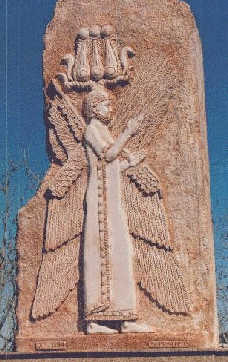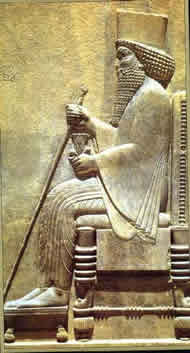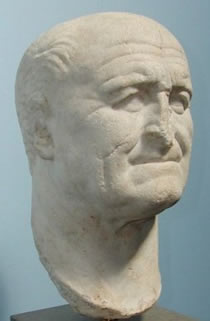From Our Archive
Dan Clendenin, This Age, That Age: Sex and the Sadducees (2013); Debie Thomas, Children of the Resurrection (2019).
For Sunday November 6, 2022
Lectionary Readings (Revised Common Lectionary, Year C)
Haggai 1:15b–2:9 or Job 19:23–27a
Psalm 145:1–5, 17–21 or Psalm 98 or Psalm 17:1–9
2 Thessalonians 2:1–5, 13–17
Luke 20:27–38
This Week's Essay
The reading from Haggai this week describes a time when the fragments of a subjugated Israel drifted along the geo-political currents of its day — the fall of Babylon and the rise of Persia. At that time, Israel was an insignificant pawn of those world empires.
Next to Obadiah, Haggai is the shortest book in the Old Testament — just two pages long. How did this scrap of a manuscript ever survive the ravages of time and chance so that we still read it 2,500 years later? But it did survive, and it speaks a word to us today, especially as Americans vote in their mid-term elections on November 8 — and hold their collective breath for the outcomes.
Haggai is classified as a prophet, even though it reads like straightforward history. He delivers four “prophecies” in four months, each of which bears a specific date. It's a combination of "forth-telling" about Israel's political present, and "fore-telling" about God's future for a disillusioned people.
As a "post-exilic" prophet, Haggai ministered to a demoralized remnant that had returned to the ruins of Jerusalem after seventy years of exile in Babylon. After Cyrus the Great of Persia conquered Babylon in 539 BCE, he issued a decree in the year 536 BCE that allowed a beleaguered remnant of Jews to return to Jerusalem to resettle their lands and to rebuild their ruined temple.
Some exiles did return, but in truth, their lives were probably better in Babylon. The good news, of course, was the possibility of repatriation; the bad and bitter news was what the exiles found in Jerusalem. Who wanted to return to the scene of national destruction?
 |
|
King Cyrus of Persia.
|
Reconstruction of the ravaged temple began in 534 BCE, but the effort fizzled out and ground to a halt (cf. Ezra 3:8ff, 4:24). Perhaps they experienced a collective post-traumatic stress syndrome triggered by returning to the scene of a national tragedy — everywhere they looked there were vivid reminders of the catastrophe of war for the losers (cf. the pictures that we see of Ukraine today).
Maybe bitterness and fatalism undermined good intentions. It's easy to imagine that a lack of skilled labor, imperfect working conditions, insufficient building materials, and under-funded budgets stymied progress. Two generations had grown up in Babylon who knew nothing of the former splendor of Solomon's temple. In fact, for some younger people who returned, their exilic experience of Judaism in Babylon involved no temple at all. Perhaps they had no interest in rebuilding the ruins of a temple?
History moved on, and in 529 BCE Cyrus died. His successor, king Darius (521–485 BC), reissued the rebuilding edict about fourteen years later, and restoration of the Jerusalem temple began once again. This "second temple," as it is still called today, was finished in the year 515 BC. To be sure, that was a victory of sorts, but it took almost a full generation, twenty years, and what was the result?
When some older Jews compared the restored second temple with Solomon's original temple, the verdict was predictable: "Who of you is left who saw this house in its former glory? How does it look to you now? Does it not seem to you like nothing?" (Haggai 2:3). Compared to Solomon's temple, the second temple was a pale and pathetic imitation, and everyone knew it. That much was true. Temple rituals that had been neglected for decades and that were unfamiliar to a younger generation led to religious defilements of all sorts (2:10ff).
 |
|
King Darius of Persia.
|
But Haggai insisted that God was every bit as present in the second temple under the Persian ruler Darius as he had been in the extravagant temple under king Solomon of Israel, or, for that matter, under the oppressive regime of king Nebuchadnezzar in Babylon when there was no temple at all.
The repatriated exiles had to start over. They had to revise their expectations about the modest restoration project and what it did and did not signify about the presence of God in their community. They had to accept their meager circumstances with brutal realism, even as they worked hard to overcome them.
They also had to believe the word of God spoken to them through Haggai: "Be strong, all you people of the land, and work. Rebuild, for I am with you," declared the Lord Almighty. "This is what I covenanted with you when you came out of Egypt. My Spirit remains among you. Do not fear. Despite the outward circumstances, I will bless you, and the glory of the second temple will outshine the splendor of the first temple."
Spoiler alert — we need to fast forward to Israel's future history, for there were further humiliations to come. The second temple completed under Haggai was enlarged by King Herod in 20 BC, but then destroyed by the Romans in the revolt of the Jews against Rome in 66–70 AD. After that, the Romans built their own temple on the site, but then, between 687 and 691 AD the 9th Caliph, Abd al-Malik, built a Muslim shrine on the site called the Dome of the Rock, where Muhammad is said to have ascended into heaven. Today the Dome of the Rock sits on the original site of the Jewish temple.
But Haggai's prophecy remains. Whether in victorious exodus out of Pharaoh's Egypt, catastrophic exile to Nebuchadnezzar's pagan Babylon, post-exilic return to the ruins of Jerusalem under the Persian rulers Cyrus and Darius, or further humiliations under Rome and the Umayyad Islamic dynasty — God was present among his people.
The outward circumstances of our lives can feel harsh beyond measure, and threaten to diminish our vision. "Does it not seem like nothing?" asked Haggai about the restored temple (2:3). Still, Haggai speaks to us today in God's ancient promise: "I am with you, do not fear, my Spirit remains among you. There can be greater glory in your lesser circumstances."
 |
|
Vespasian (AD 69-79), Roman emperor
when the second temple was destroyed. |
Haggai says that God meets us where we are, not where we wish we could be, even and especially in downsized circumstances like a rebuilt temple in a ravaged Jerusalem. His Spirit moves even when we might not see or feel his presence. When we least expect it, in the dust and dirt of our lives, God says, "From this day on I will bless you" (Haggai 2:19).
When I think of the unique historical circumstances of Israel, and listen to the prophet Haggai, I'm encouraged. Here is a people living in desolation, fear, poverty, discouragement, disillusionment and ritual defilement. And what does God say to them?
* Do not fear
* I am with you (2 times)
* I will bless you (2 times)
* Be strong (3 times)
* Work, rebuild
* My Spirit remains among you
* I will grant peace
* The glory of the second temple will outshine the glory of Solomon's temple
Haggai reminds us that God works in our midst even when we might not feel or see it. Haggai exemplifies what Brueggemann calls energizing hope in a hopeless situation. His word to them and to us is precisely this: “Give careful thought. Despite outward appearances, I am working. Believe it. See it. Be strong, for my Spirit is with you. I want to bless you.”
Weekly Prayer
Taken from The Valley of Vision: A Collection of Puritan Prayers & Devotions, edited by Arthur Bennett.
Lord, high and holy, meek and lowly,
Thou hast brought me to the valley of vision,
where I live in the depths but see Thee in the heights;
hemmed in by mountains of sin I behold Thy glory.
Let me learn by paradox that the way down is the way up,
that to be low is to be high,
that the broken heart is the healed heart,
that the contrite spirit is the rejoicing spirit,
that the repenting soul is the victorious soul,
that to have nothing is to possess all,
that to bear the cross is to wear the crown,
that to give is to receive,
that the valley is the place of vision.
Lord, in the daytime stars can be seen from deepest wells,
and the deeper the wells the brighter Thy stars shine;
let me find Thy light in my darkness,
Thy life in my death,
Thy joy in my sorrow,
Thy grace in my sin,
Thy riches in my poverty,
Thy glory in my valley.
Dan Clendenin: dan@journeywithjesus.net
Image credits: (1) Crystalinks.com; (2) Hellenica; and (3) Antony Kamm's The Romans.





